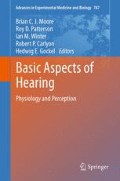Abstract
It is possible that previous psychophysical estimates of basilar membrane gain and compression using temporal masking curve (TMC) and additivity of forward masking (AFM) methods using long-duration maskers (>30 ms) could have been affected by activation of the medial olivocochlear reflex (MOCR) (Jennings et al. ; Plack and Arifianto ). In experiment 1, AFM and TMC methods were compared to a new fixed-duration masking curve (FDMC) method in which the combined masker and signal stimulus duration is fixed at 25 ms. Estimates of compression were found to be not significantly different for TMC, FDMC and AFM methods. Estimates of gain were similar for TMC and FDMC methods. Maximum compression was associated with a significantly lower input masker level using the FDMC compared to the TMC method. In experiment 2, the FDMC method was used to investigate the effect of efferent activation on gain and compression estimates by presenting a precursor sound prior to the combined masker-signal stimulus. Estimated gain decreased as precursor level increased, and increased as the silent interval between the precursor and combined masker-signal stimulus increased, consistent with a decay of the efferent response.
Access this chapter
Tax calculation will be finalised at checkout
Purchases are for personal use only
References
Backus BC, Guinan JJ Jr (2006) Time-course of the human medial olivocochlear reflex. J Acoust Soc Am 119:2889–2904
James AL, Mount RJ, Harrison RV (2002) Contralateral suppression of DPOAE measured in real time. Clin Otolaryngol 27:106–112
Jennings SG, Strickland EA, Heinz MG (2009) Precursor effects on behavioural estimates of frequency selectivity and gain in forward masking. J Acoust Soc Am 125:2172–2181
Liberman MC, Puria S, Guinan JJ Jr (1996) The ipsilaterally evoked olivocochlear reflex causes rapid adaptation of the 2f 1-f 2 distortion product otoacoustic emission. J Acoust Soc Am 99:3572–3584
Lopez-Poveda EA, Plack CJ, Meddis R (2003) Cochlear nonlinearity between 500 and 8000 Hz in listeners with normal hearing. J Acoust Soc Am 113:951–960
Murugasu E, Russell IJ (1996) The effect of efferent stimulation on basilar membrane displacement in the basal turn of the guinea pig cochlea. J Neurosci 16:325–332
Nelson DA, Schroder AC, Wojtczak M (2001) A new procedure for measuring peripheral compression in normal-hearing and hearing-impaired listeners. J Acoust Soc Am 110:2045–2064
Plack CJ, Arifianto D (2010) On- and off-frequency compression estimated using a new version of the additivity of forward masking technique. J Acoust Soc Am 128:771–785
Plack CJ, O’Hanlon CG (2003) Forward masking additivity and auditory compression at low and high frequencies. J Assoc Res Otolaryngol 4:405–415
Plack CJ, Oxenham AJ, Simonson A, O’Hanlon CG, Drga V, Arifianto D (2008) Estimates of compression at low and high frequencies using masking additivity in normal and impaired ears. J Acoust Soc Am 123:4321–4330
Plack CJ, Drga V (2003) Psychophysical evidence for auditory compression at low characteristic frequencies. J Acoust Soc Am 113:1574–1586
Rosengard PS, Oxenham AJ, Braida LD (2005) Comparing different estimates of cochlear compression in listeners with normal and impaired hearing. J Acoust Soc Am 117:3028–3041
Roverud E, Strickland EA (2010) The time course of cochlear gain reduction measured using a more efficient psychophysical technique. J Acoust Soc Am 128:1203–1213
Strickland EA (2008) The relationship between precursor level and the temporal effect. J Acoust Soc Am 123:946–954
Tukey J (1977) Exploratory data analysis. Addison-Wesley Publishing Co., Reading
Yasin I, Plack CJ (2003) The effects of a high-frequency suppressor on tuning curves and derived basilar membrane response estimates. J Acoust Soc Am 114:322–332
Acknowledgements
The research was supported by EPSRC grant EP/H022732/1.
Author information
Authors and Affiliations
Corresponding author
Editor information
Editors and Affiliations
Rights and permissions
Copyright information
© 2013 Springer Science+Business Media New York
About this paper
Cite this paper
Yasin, I., Drga, V., Plack, C.J. (2013). Improved Psychophysical Methods to Estimate Peripheral Gain and Compression. In: Moore, B., Patterson, R., Winter, I., Carlyon, R., Gockel, H. (eds) Basic Aspects of Hearing. Advances in Experimental Medicine and Biology, vol 787. Springer, New York, NY. https://doi.org/10.1007/978-1-4614-1590-9_5
Download citation
DOI: https://doi.org/10.1007/978-1-4614-1590-9_5
Published:
Publisher Name: Springer, New York, NY
Print ISBN: 978-1-4614-1589-3
Online ISBN: 978-1-4614-1590-9
eBook Packages: Biomedical and Life SciencesBiomedical and Life Sciences (R0)

